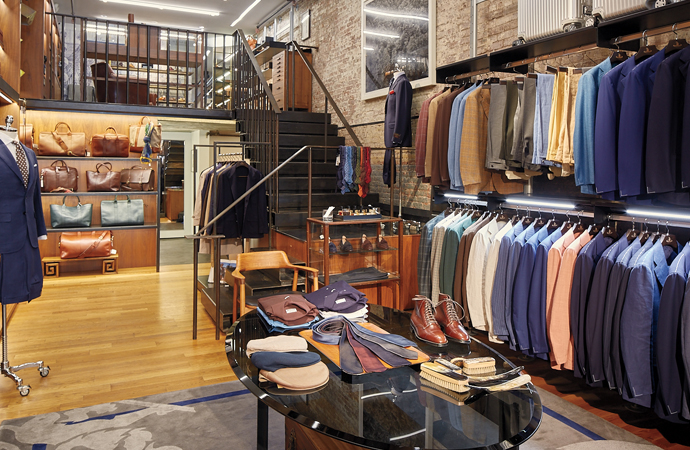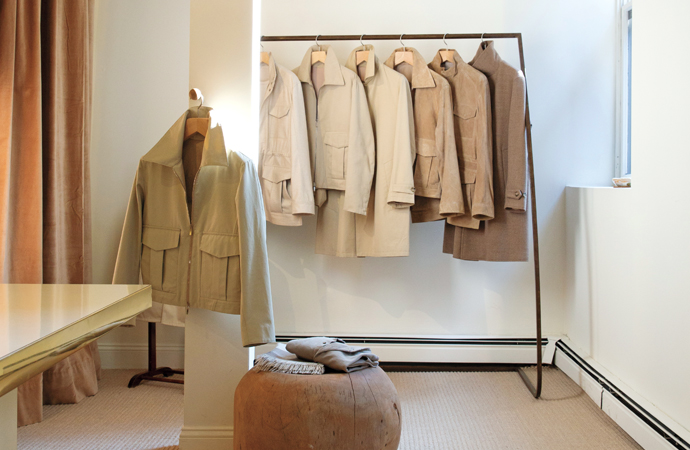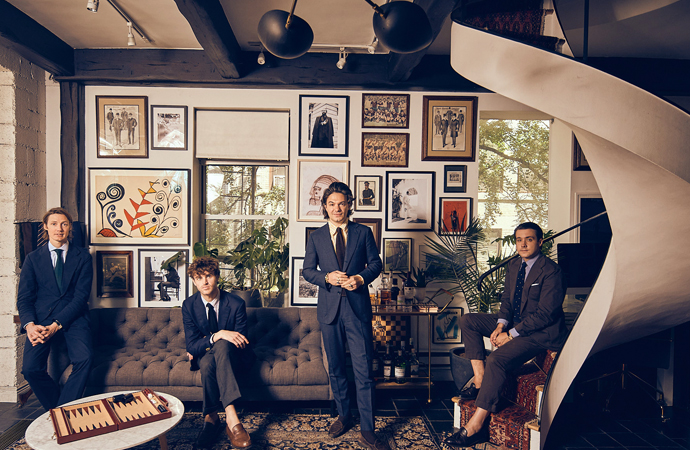Classic Suits with a Twist Are All the Rage in Lower Manhattan
Now that suits are no longer compulsory, people want to wear them
June 13, 2023

P. Johnson, SoHo / Photo: Courtesy of Glen Allsop
For years, fashion commentators have been sounding the death knell for the classic two-piece suit. Office culture had been upended, Americans were dressing more casually than ever, and boarding a plane in pajamas was socially acceptable. Covid should have been the coup de grâce. Instead, it brought a new energy to formality.
Most people don’t need to wear a suit anymore. Yet, as with most top-down directives, once the suit was no longer compulsory, people actually wanted to wear one. This reversal has been wholly embraced by the creative class. Artists, musicians, writers—along with their trusted tailors—have reinvigorated contemporary suiting.
Until recently, there had been a dearth of high-quality custom suit shops in Lower Manhattan. Now there’s an embarrassment of riches, aided by a new wave of designers, tailors and clients. Many Downtown bars and workspaces are crawling with bons vivants wearing expertly tailored suits or unconventionally cut blazers. Here, a list of some of the best tailoring in Downtown New York City.

The Armoury / Photo: Courtesy of Harry Zerinike
The Armoury
168 Duane St.
With multiple locations in Hong Kong and New York City and partnerships with the finest artisans across Europe and Asia, The Armoury is a trusted barometer for shifting sartorial sensibilities. “Since the pandemic, people have begun rethinking their basics,” says Daniel Greenwood, sales manager at The Armoury’s NYC flagship in TriBeCa. “We’ve never sold as many navy and gray suits as right now. At the same time, we’ve never sold as many polos and chinos either.”
Greenwood confirms the ascendant high-low dynamic in modern wardrobes, which acts as a portal into more tailored clothing by combining dressy and casual items. “We try to remove the psychological blocks that sometimes inhibit people from wearing certain things,” he says.
The Armoury’s long-standing house suit is produced by Ring Jacket, the premium Osaka-based manufacturer, which blends American, English and Southern Italian flourishes with its Japanese roots. The style has a uniquely cosmopolitan flair—slightly relaxed in the chest, with a wider lapel and shoulder, but a shapely abdomen and waist. “Modern but still classic,” Greenwood says. “Covid accelerated the desire for ease and comfort while still being flattering.” For those with more cultivated tastes (and deeper pockets), The Armoury is one of the few locations in North America that hosts trunk shows and fittings by Liverano & Liverano—the heritage Florentine tailoring shop, among the finest bespoke suit makers in the world.

Stòffa, SoHo / Photo: Courtesy of Stòffa
Stòffa
54 Mercer St.
“We set out to make everything one at a time,” says Stòffa cofounder Nicholas Ragosta. From sumptuous knitwear and outerwear to trousers, shirts and suiting, each garment is meticulously produced in Italy to the specifications of each client, prioritizing guest experience and waste reduction.
The label existed as a traveling pop-up for roughly five years before finally getting a permanent showroom above Mercer Street in 2019. Stòffa now launches several collections each year based around seasonal color palettes and beautiful proprietary fabrics—such as velvety cashmere, water-repellent suede, slinky tropical wool and stout cotton canvas—which can be rendered into several different styles using the same single-unit production model.
As the world trends toward softer fabrics and more fluid drapes, Stòffa has solutions for those who wish to maintain a sense of elegance. Its house suit was developed as a collaboration with NYC-based artist Landon Metz, who was looking for something that would allow him to move seamlessly from his studio to a meeting with a collector or a gallery opening.
“We wanted a suit designed for today, now that the context for wearing one isn’t the standard business uniform,” Ragosta says. The result, as with the rest of the line, is a harmony between futuristic silhouettes and the craftsmanship and quality of old-world masters.

Drake’s, TriBeCa /. Photo: Courtesy of Drake’s
Drake’s
327 Canal St.
Over the last decade, Drake’s—founded in London’s East End in 1977—has made a remarkably successful transition from an obscure manufacturer of luxury neckties and accessories to a fresh and innovative full-look brand. The so-called “Drake’s aesthetic”—a modern mélange of classic styles like American Ivy, British country and vintage sportswear—can be seen parading through the streets of SoHo, Tokyo, Seoul and beyond.
The brand’s U.S. outpost opened last year on Canal Street, at the intersection of some of Lower Manhattan’s most vibrant art galleries, bars, restaurants and vintage shops. It’s a colorful, modular space, with Ethiopian jazz lilting through the house speakers, modeled after the open-studio concept of TriBeCa artists during the 1970s. Aside from a regular program of events and art exhibitions, there is a dedicated made-to-order tailoring space that pays homage to the brand’s Savile Row pedigree.
The distinctive yet easygoing Drake’s suit—rendered in sturdy linen, cotton canvas, corduroy or tropical wool, and produced in Italy—is a standard-bearer in modern menswear and can be purchased off the rack or made-to-measure. Unfussy and unstructured, these are utilitarian suits meant for everyday use, whether with a shirt and tie or knit polo.
“Great tailoring shouldn’t be dull or restrictive,” says Drake’s editor, Finlay Renwick. “It should be comfortable, timeless and interesting to wear.”

P. Johnson, SoHo / Photo: Courtesy of Glen Allsop
P. Johnson
400 W. Broadway
The Australia-born, globe-trotting designer Patrick Johnson established his label’s New York City showroom last year, offering a range of his trademark soft tailoring and formal wear for P. Johnson and P. Johnson Femme lines. Over the last couple of years, Tom Riley, a founding partner of P. Johnson, has noticed a return of what he calls “power dressing,” or “a slightly nostalgic moment mixed with a simple relish or enjoyment in dressing for the office.” There has also been an embrace of more stylish semiformal clothing, as well. “Streetwear is being jettisoned in favor of a little more classicism.”
The airy, art-filled loft on West Broadway was designed by Johnson’s wife, Tamsin, a renowned interior decorator, to convey a warm and inviting atmosphere that feels more like an extension of the couple’s living room on Bondi Beach than a traditional store. House specialties are lightweight suits, mostly in solid colors, that can be easily dressed up or down, interspersed with a rakish mix of sportswear such as a quarter-zip pullover.

Jonas Sundstrom, Matthew Woodruff, Jake Mueser and Chase Winfrey at J. Mueser, West Village / Photo Courtesy of Zeph Colombatto
J. Mueser
19 Christopher St.
Since its founding in 2008, J. Mueser has been credited with developing New York City’s signature style, guided by the various cultural influences that run throughout the city. Think mid-century avant-garde musicians and filmmakers in Neapolitan and English tailoring, and then swap the dress shirt and tie for a Western shirt or fine-knit turtleneck (in other words, peak Serge Gainsbourg).
Lately, the label’s Greenwich Village haberdashery and showroom has been busier than ever, and founder Jake Mueser says that uptick in sales is guided by a sense of passion, not obligation. “You no longer have to buy a suit,” he says. “People are driven by interest and enthusiasm for tailoring instead. That’s been a really interesting shift.”
House staples include soft-shouldered blazers in tweed, worsted wool or cashmere, and more structured double-breasted suits. Recently, the brand partnered with Emilie Hawtin—editorial director at J. Crew—on an elegant linen suit for women.
For the house’s bespoke process, measurements are taken, fabrics are chosen, and the specs are sent off to an atelier in Italy, where the suits are made. Roughly four weeks later, the client comes back in for the first in a series of fittings. Mueser understands this process can be daunting for newcomers, so the mission is to keep things fun and inviting.
“We’re here to filter all the different elements and options into something that works for each client,” Mueser says. “We want to make the article of clothing that gets worn the most, not the thing that hides in your closet.”



